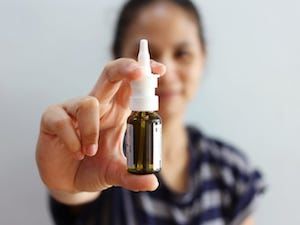Ketamine
Esketamine and the Search for New Ways to Treat Depression
Re-analysis of FDA data raises questions about the drug’s safety and efficacy.
Posted December 27, 2019 Reviewed by Lybi Ma

When the U.S. Food and Drug Administration voted in March 2019 to fast-track approval of the synthetic drug ketamine for severe, treatment-resistant depression, questions were raised about the supporting evidence that have only intensified in the months since.
The agency approved the clinical use of esketamine as a nasal spray, sold under the name Spravato, one of whose key components is a form of ketamine. First synthesized in 1962, ketamine is known as a powerful anesthetic, but also to produce dissociative effects that can be hallucinogenic (as a street drug, popular among ravers, the drug is known as “Special K”). Both variants of the drug appear to work “mainly through stimulation of opioid receptors,” notes Peter C. Gøtzsche of Copenhagen’s Institute for Scientific Freedom and six other leading European researchers associated with the Council for Evidence-Based Psychiatry.
“Rarely has there been so much anticipation for a new antidepressant as has been seen for intranasal esketamine,” observed Alan F. Schatzberg in the June issue of American Journal of Psychiatry. The former American Psychiatric Association president was summing up concern about existing treatment options for depression after a renewed focus on the effectiveness of SSRI antidepressants, the prevalence of antidepressant withdrawal, and ongoing questions about the relationship between serotonin and depression. Schatzberg’s commentary, “A Word to the Wise about Intranasal Esketamine,” nonetheless stressed “a number of worrisome findings” tied to the drug’s FDA approval, just one of which was “whether efficacy has been truly demonstrated.”
“A Word to the Wise” focused on whether esketamine’s “opioid properties may explain the drug’s abusability and raise concerns regarding liability with longer-term use.” “Do we have a real sense of how long and how often to prescribe [intranasal esketamine]?” Schatzberg asked, regarding the findings of three-month-long studies included as FDA documentation. “It’s not entirely clear.”
“What is more worrisome than [the] rapid relapse” documented in the short-term trials, he continued,
were the three suicides that occurred 4-20 days after the last dose of esketamine (there were none in the placebo group). Two of the patients who died by suicide showed no previous signs of suicidal activity during the study, either at baseline or at the last visit. This suggests a protracted withdrawal reaction, as has been reported with opioids, and one that is different from the more physical withdrawal symptoms seen acutely with opioids.
“We have witnessed four decades of supposedly new and safer opioids that have turned out to be, if anything, even more abusable and lethal,” the former American Psychiatric Association president concluded, raising the specter of a renewed cycle of hype and overprescribing that longer-term findings could again reveal to have been lethally addictive—to have fueled cravings and behaviors that would end up ravaging lives and communities across the U.S. and, with the exportation of opioids, far beyond it.
The December publication of a significant re-analysis of the FDA data puts these concerns in yet starker light. In the Cambridge journal Epidemiology and Psychiatric Sciences, researchers at the University of Verona, led by Chiara Gastaldon, present a “re-analysis of the primary efficacy data” and similarly find it wanting, including in previously unexamined ways.
In “Esketamine for treatment-resistant depression: A trick of smoke and mirrors?” Gastaldon and colleagues note that two of the three short-term studies used for FDA approval did not find statistically significant reductions in depressive symptoms, even as they raised concerns over potential side effects and relapse rates from withdrawal.
Re-analysis of data on the incidence of dissociation showed that “esketamine increased by seven times the risk of this adverse effect over placebo,” for example, “with approximately 25 percent of patients receiving esketamine who experienced severe dissociation during treatment.”
With more than 2,000 clinical sites already certified in the U.S. to dispense Spravato, according to its drug-maker, “long-term data” on the drug’s impact “are completely lacking,” note Gastaldon’s team, highlighting esketamine’s approval on limited, short-term understanding. The FDA chose in this instance to calculate efficacy against placebo rather than against an active competitor, in effect making “a demonstration of efficacy against placebo … enough to grant a marketing authorisation.” The reduced threshold raises significant concerns about a drug that is already associated with addiction, acute relapse rates, and a long list of known side effects, among them “sleepiness, dizziness, anxiety, and feelings of disconnection, vomiting, and increased blood pressure, and bladder problems.”
The one short-term study that after 24 hours of monitoring found a significant difference when comparing esketamine + antidepressant with placebo + antidepressant risked confusing the drug’s effects with euphoria, note Professor Gøtzsche and colleagues in the British Medical Journal, a temporary high that could leave the underlying depression untouched and unaffected. “We are convinced it could be demonstrated that alcohol, morphine, cocaine, ecstasy, and MDMA also exert an ‘effect’ on depression within the first day,” Gøtzsche and colleagues explained, “but that does not make these substances acceptable. They may have acute euphoric effects, but frequent and long-term use often results in dysphoric mood states.”
Despite these concerns and objections, the European Medicines Agency (EMA) last week agreed to approve esketamine for severe, treatment-resistant depression, on terms almost identical to those adopted by the FDA. A number of researchers fear the UK’s equivalent, the Medicines and Healthcare Products Regulatory Agency (MHRA), will follow suit, despite criticism in the nation’s flagship medical journal over the drug’s limited evidence base.
“[Esketamine] is not safe until we know what the long-term effects are,” cautions London-based medical researcher John Read, among those urging restraint. “They can mess around the edges, but the only way to be safe is to withhold it until it has been properly tested.”
In the coming months and years, questions no doubt will intensify in the U.S. and Europe as to why regulators responsible for following that clear and sound protocol ultimately decided not to.
References
Gastaldon C, Papola D, Ostuzzi G, and Barbui C. (Jan. 2020). “Esketamine for treatment resistant depression: A trick of smoke and mirrors?” Epidemiology and Psychiatric Sciences 29, E79. doi:10.1017/S2045796019000751 [Link].
Gøtzsche P, Hengartner M, Davies J, Read J, Guy A, Timimi S, and Kinderman P. (Oct. 3, 2019). “Esketamine for depression? No thanks, please.” BMJ 2019; 366 [Link]
Jauhar S, Morrison P. (Sept. 23, 2019). “Esketamine for treatment resistant depression. We should cautiously welcome this new therapeutic option.” BMJ 2019; 366: l5572. [Link]
Mahase E. (Dec. 20, 2019). “Esketamine is approved in Europe for treating resistant major depressive disorder.” BMJ; 367: 17069. [Link]
Schatzberg A. (Jun. 2019). “A Word to the Wise about Intranasal Esketamine.” Am J Psychiatry 176:422-24; doi: 10.1176/appi.ajp.2019. 19040423. [Link]




